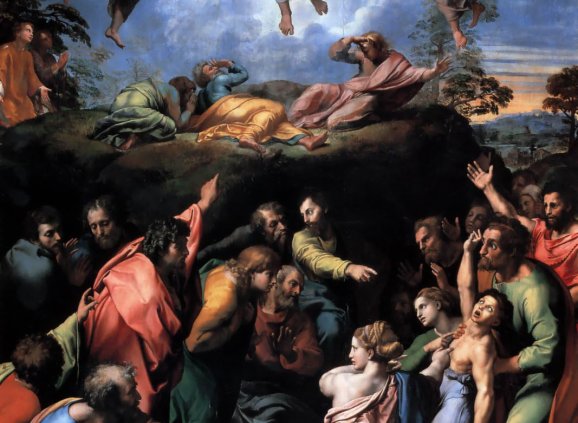
- Education Forums
Bible Study Guide for Last Sunday After Epiphany, Year A

- Exodus 24:12-18
- 2 Peter 1:16-21
- Matthew 17:1-9
- Psalm 2 OR Psalm 99
Two experiences taint my reading of the Transfiguration miracle. The first is actually more properly a set of experiences, in that more often than not—as a kid in Sunday School, as I’ve heard from the pulpit throughout my life, as a teenager in various Bible studies, and even as an adult looking at historical exegetical treatments of the pericope—Peter’s one-liner within the story often captures a disproportionate amount of attention in its interpretation. God stops Peter’s declaration that he will build three dwellings for Jesus, Moses, and Elijah with a seemingly stern rebuke, given that the “bright cloud” interrupts Peter “while he is still speaking” and then completely ignores what Peter has just said (Mt. 4-5). Second, I cannot read this story apart from a visit I took to the Vatican as an undergraduate college student: I distinctly remember being caught by Raphael’s painting of the miracle, which hung a short distance away from the purported location for St. Peter’s tomb. “How funny,” I remember thinking, “that a picture depicting God’s rebuke of Peter’s desire to build a monument for Christ hangs here, of all places!”

As I pore over this text again, however, what strikes me is just how much my previous assumptions surrounding it are perhaps even more short-sighted than Peter’s remark. His desire to build a dwelling to demarcate a sacred space is warranted by the Hebrew scriptures, which are filled with such references (for some examples, Jacob’s designation of Bethel as a Holy Place in Gn. 28:18-19; the Lord’s instructions for the construction of a tabernacle in Ex. 25:1-9). I am thinking also of how the Hebrew scriptures are likewise replete with references to a certain experience of terror that accompanies the human encounter with God: for some examples, no one but the High Priest may enter the Holy of Holies on the Day of Atonement, lest they be struck dead (Lev. 16); God instructs Moses to remove his sandals when God calls to him from the burning bush, “for the place on which you are standing is holy ground” (Ex. 3:5); both today’s appointed Psalms speak of a King who invokes fear, one whose “rage fills [the kings and princes of the earth] with terror” (Ps. 2:5) and who can “crush them with an iron rod” (Ps. 2:9). Today’s reading from Exodus indicates that, in order to receive the Law, Moses had to commune with God atop Mt. Sinai veiled by a cloud—this, because “the appearance of the glory of the Lord was like a devouring fire on the top of the mountain in the sight of the people of Israel” (Ex. 24:17). These Scriptures provide a stark reminder regarding the awesome fearsomeness of God, whose presence is so wondrous and overwhelming to behold that—were it not veiled behind a holy cloud—a “face-to-face” encounter with God’s glory might very well strike the creature dead.
And then we have poor, misunderstood Peter in the Gospel text, who—along with James and John—bears witness to that glory in a “face-to-face” encounter through the miracle of the Transfiguration. It’s useful to recall that Peter, James, and John were Jewish and would have been quite familiar with the scriptural precedent regarding the terror endemic to a divine showing of this kind: it is as though the “cloud” or “veil” that separates us from God’s glory has here been ripped away for these three disciples, who serve as “eyewitnesses to God’s majesty” in Jesus (2 Ptr 1:16). Of course Peter is terrified. Of course he desires to designate the mountain a sacred space, and of course all three disciples fall down afraid. Looking at images of Raphael’s interpretation of this miracle (included, below!), in another rebuke to my undergraduate smugness, I’m also caught by how well the Renaissance painter captured the scripturally warranted terror of such a Divine unveiling.
What, then, do we do with this story? What does it mean for us? It’s useful to regard what precedes the story of the Transfiguration here in Matthew: Jesus foretells his death and resurrection to the disciples in Ch. 16: 21-23, followed by this speech in vs. 24-28: “If any want to become my followers, let them deny themselves and take up their cross and follow me .... For the Son of Man is to come with his angels in the glory of his Father, and then he will repay everyone for what has been done. Truly I tell you, there are some standing here who will not taste death before they see the Son of Man in his kingdom.” Rather notably, the other synoptic Gospels both include some version of this same speech before their accounts of the Transfiguration as well (see Mk 8:31-9:1; Lk 9:23-27). While we might be tempted to read Jesus’s words here eschatologically, another way of reading these speeches might suggest that his prophecy is fulfilled by the Transfiguration miracle itself: indeed, James, John, and Peter all witness the coming of God’s Kingdom through the unveiling of God’s glory in the person of Christ in the story that follows (and this is the case in each of the synoptic gospels).
In this reading of the miracle, the Divine interruption from the clouds should maybe be understood less as a rebuke to Peter and more as a sign of hope—the veil has been removed! The Kingdom of God has arrived! “This is my Beloved; with him I am well pleased; listen to him!” (Mt. 17: 5) Jesus just told you that some of you will see the Kingdom of God and will find life through the Cross: Here I am, and here it is! “Get up and do not be afraid,” says Jesus to Peter, James, and John, echoing the angel’s words to Joseph in the Nativity story. Through willingly approaching the cross and through the coming resurrection, Jesus brings the glory of God’s Kingdom to creation; the disciples—and indeed, all of creation—need no longer be afraid, because the transcendent God is now immanently available to everyone in Christ.
In these ways, the Transfiguration story foreshadows the hope of the Resurrection—which lies on the other side of the cross, Christ’s suffering, and the disciples’ grief—even if the disciples can’t yet see it. The accompanying collect for this week’s lectionary provides a fitting conclusion here: “Oh God, who before the passion of your only begotten Son revealed his glory upon the holy mountain: Grant to us that we, beholding by faith the light of his countenance, may be strengthened to bear our cross, and be changed into his likeness from glory to glory; through Jesus Christ our Lord, who lives and reigns with you and the Holy Spirit, one God, for ever and ever. Amen.”
– Katie Wrisley Shelby
What does the Transfiguration miracle mean to you? How do you understand this story with respect to what you’ve encountered thus far in our collective reading of Matthew’s Gospel?
Why do Elijah and Moses appear with Jesus in this miracle? What would they have signified to James, Peter, and John?
The collect for this reading asks that we “be changed into [Christ’s transfigured] likeness from glory to glory;” what do you think this means?
Why is the appearance of God’s “glory” so terrifying?
- January 2024
- December 2023
- November 2023
- October 2023
- September 2023
- June 2023
- May 2023
- April 2023
- March 2023
- February 2023
- January 2023
- December 2022
- November 2022
- October 2022
- June 2022
- May 2022
- April 2022
- March 2022
- February 2022
- January 2022
- November 2021
- October 2021
- September 2021
- August 2021
- July 2021
- June 2021
- May 2021
- April 2021
- March 2021
- February 2021
- January 2021
- December 2020
- November 2020
- October 2020
- September 2020
- August 2020
- July 2020
- March 2020
- February 2020
- January 2020
- December 2019
- November 2019
- October 2019
- September 2019
- August 2019
- July 2019
- June 2019
- May 2019
- April 2019
- March 2019
- February 2019
- January 2019
- December 2018
- November 2018
- October 2018
- September 2018
- August 2018
- July 2018
- June 2018
- May 2018
- April 2018
- March 2018
- February 2018
- January 2018
- December 2017
- November 2017
- October 2017
- September 2017
- July 2017
- May 2017
- April 2017
- March 2017
- February 2017
- January 2017
- December 2016
- November 2016
- October 2016
- September 2016
- August 2016
- May 2016
- April 2016
- March 2016
- February 2016
- January 2016
- December 2015
- November 2015
- October 2015
- October 2013
- September 2013
At "Educational Forums," enrich your spiritual journey by exploring our resources including videos of lectures, essays by priests, and other pieces about our faith, our church, and what it means to be a disciple of Jesus in the 21st century.


Comments